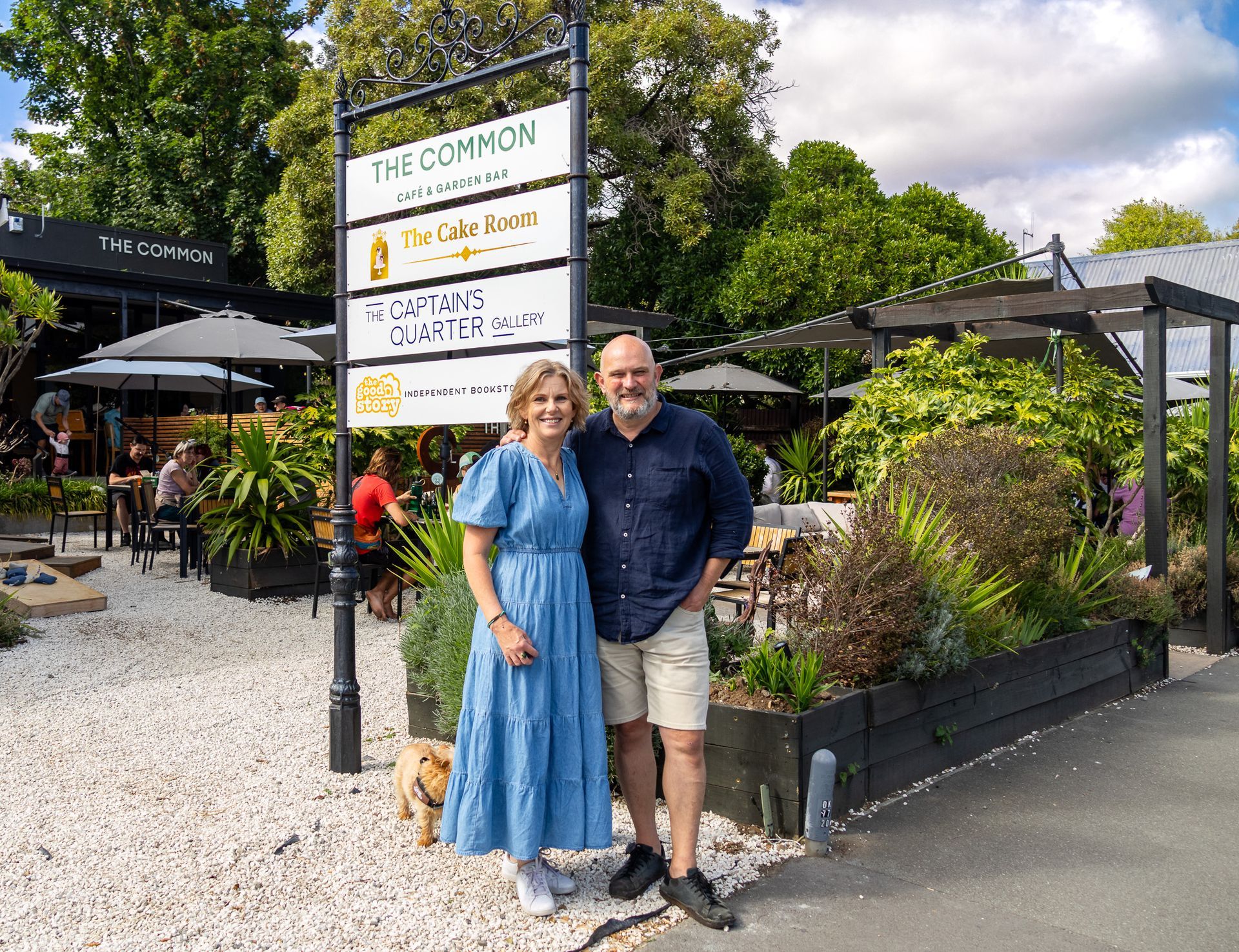Gold at heart, down to earth and appreciated by many; the qualities of the Hislop family, one with a rich and fascinating history, are wonderfully similar to the product that has defined their industriousness over time: honey.
As we travel along the road from Kaikōura to the Clarence Valley, Nick Parkinson and his nephew, Quintin, are
pointing out to me the local evidence of apiculture’s newfound race to the top, and the turbulence that has accompanied it.
‘Big business has swept through these valleys and thrown around some serious money, and small apiaries are struggling
to keep up. But we just have to keep ticking along.’ Nick’s comments reflect an increasingly prevalent discourse
that has begun to untwist the lid on the honey industry, and the taste, as it turns out, is not so sweet. Hive overpopulation,
sabotage of apiaries, and the spread of pests and diseases adept in decimating bee populations are just some of the issues
having severe consequences on local honey producers. But nothing is ramming honest, small businesses out of the market
like the ‘gold rush’ that has become the marketing of Mānuka honey; the wringing of the honey bee for all the gold it can
produce, and not the kind that is spread on toast.
We arrive at the gate to Clarence Reserve Road, leading into the heart of the valley, and begin to climb towards a
saddle in the Seaward Kaikōuras. We wind around sections of the road with colloquial titles such as ‘Jailhouse Rock’ and
‘Dead Horse Gulley’, mostly labelled after unforgettable incidents, such as when Paul Hislop, Nick’s brother-in-law,
suffered a brake failure in his tractor which subsequently rolled off a ledge and into the gorge below, almost taking Paul
with it. After an hour into the drive, we weave through a tight bend and reach the crescendo of the journey: a sweeping view
into the Clarence Valley.
-
Button
Amidst a swarm of bees, Ivan attempts to extract honey from hives in the Clarence Valley whilst his son, Paul, dutifully photographs the process. Note the lack of gloves; a common practice which maintains dexterity in such a delicate operation, all the while enduring several bee stings. Photograph circa 1970s, supplied by Hislop Family.
-
Button
Our journey into the Clarence Valley was hot and dusty. Nick attends the ‘Running Mead’ rest stop tucked into the folds of the Seaward Kaikōura mountains, frequented by Hislop family members for the better part of the last century.
‘All that flowering over there, that’s Mānuka, but all this through here are our Blue Borage apiary sites,’ says Nick with
a grin, waving his hand across the foreground. In a week’s time, the area is due to turn from green to the Persian blue of the Borage flower. Nick’s tone, and the way he brushes past the Mānuka bushes, betrays a slight anguish when addressing the topic of New Zealand’s prominent honey. ‘
All these plants could have medicinal value, and all honeys are known to contain health benefits. But the obsession with Mānuka is
causing us to overlook this reality.’
We pull over quickly to fill our water bottles in a trickling waterfall tucked into the side of the road. The landmark, labelled by Nick as the ‘Running Mead’, has been a frequented rest stop on the journey into the Clarence Valley by members of the Hislop family across several generations.
A few decades ago, Nick Parkinson married his wife,Hellen, daughter of Ella and Ivan Hislop, and quickly adopted the Hislop respect for the industrious honey bee and the land that they are kept on. As well as carrying on the family’s organic honey production company, now known as Mountain Honey, he also owns and operates New Zealand’s only organically certified meadery, Hexagon Mead. The jewel on its golden necklace: a barrel that fermented during the infamous 2016 Kaikōura earthquake.
Maintaining organic certification has many additional primary production requirements – including the use of improvised, chemical-free treatments of pests, and ensuring bees are left over winter with sufficient honey to feed themselves – all requirements that the Hislops embrace as second nature. ‘It’s all about sustainability of agriculture, and it starts with the soil. We’ve got to take care with our farming practices and look after
nature,’ says Paul.
As well as keeping his own apiaries, Paul and his wife, Elizabeth, own and operate a wholefoods caf. in Kaikōura, the meals on their menu being produced largely from ingredients harvested from their own land. ‘Wholefoods means using ingredients in their most original state; nothing added, nothing removed,’ explains Elizabeth.
The family’s organic and wholefoods focus began with Paul’s late uncle, Archie, and his parents, Ella and Ivan, who began beekeeping as a hobby over 70 years ago. Archie, having studied husbandry abroad in the United Kingdom, commercialised Ivan’s hobby, utilising beekeeping techniques now widely recognised as organic practice – he was just doing it 50 years before the term was coined. Eventually, Ivan and Archie went into business with their cousin, Jim Godfrey, and Kaikōura Apiaries, now known as Mountain Honey was founded.
When Paul was 13, the business was invited by a local shepherd to explore the land between the Seaward Kaikōura mountains for apiculture purposes, beginning what has been a long and close relationship with the Clarence Valley and the farms that border it. Ivan, now in his early nineties, possesses the hands of a man who has relied upon their toil his entire life. I met him in his shed welding components of his fireplace back together.
When he looked up in surprise at me and Quintin, a coy smile began to spread across his face. ‘They don’t like it when I do this kind of stuff,’ he said with a chuckle; ‘they’ being his concerned extended family and ‘this kind of stuff ’, technical labour that you would typically expect from a young tradesman. Just the week before, Paul found Ivan atop a tall ladder fixing his own chimney. But, like many a Kiwi of yesteryear, living by the fruit of your labour has been the axiom of the Hislop family unit.
The Hislops’ biography and artisan flair is being ably carried into the future atop the shoulders of the youngest generation. Quintin, Paul’s son, opened his own honey and coffee shop in Kaikōura’s Uplift Container Mall. Creatively labelled the BeeBox, Quintin has embellished the walls and shelves with photographs and mementos enshrining the history of the Mountain Honey products sold in his shop – Blue Borage, Honeydew and, of course, Mānuka – the latter of which has now become the staple of New Zealand apiculture. ‘I recognise that more people are becoming conscious purchasers. The mission of the BeeBox will be to market local beekeepers who are producing their honey in a sustainable fashion.’
Whilst sitting inside his shop and enjoying a coffee with a dash of honey, you cannot help but absorb the rich backstory of the Hislops’ dedication to organic honey production. And when it comes to the backstory of honeys, according to Ivan, it seems Mānuka’s is not so glamorous. ‘It used to be feed-honey for our bees,’ he explains. ‘No one liked the strong flavour.’
I must note the brave, selfless statements of this nature, given much of the family business relies on the sale of Mānuka honey. Their frustration, though, is justified. The Mānuka producing industry has been the subject of an increasing amount of ‘bad press’ in recent years, mostly due to the consequences of over-capitalisation, or the Mānuka gold rush. Apiary theft is now a prevalent, and commonly premeditated issue: 400 cases were reported in one six-month period, and one of those incidents involved $50,000 worth of
theft in a single heist.
A 500 mg bottle of Mānuka honey, with a Unique Mānuka Factor (UMF) rating of 15+ can fetch $150, compared to $30 for the same size bottle with a rating of 5+. Alas, therein lies the problem: what do those extra 10 rating points in fact mean? Who is a 15+ rating appropriate for?
And, is this methylglyoxal activity – the property of Mānuka honey targeted by UMF – actually effectual when eaten? ‘Many tourists walk into my shop asking for 20+ Mānuka honey,’ says Quintin. ‘When I ask them why they want honey graded in this manner, they can never give me an answer. The marketing has just convinced them that a higher rating must be better. It’s my job to educate customers on the actual indicators of pure Mānuka honey, as outlined by the Ministry for Primary Industries [which are not the indicators used by the UMFHA, the Unique Mānuka Factor Honey Association], and comfort them that they will receive a quality product no matter which honey they purchase.’
It is not just UMFHA that has designed an esoteric, but cleverly marketed rating system. Another model, MGO, grades Mānuka honey based on its methylglyoxal count exclusively; therefore, products with the MGO trademark are labelled with much higher, more impressive numbers, typically anywhere between 100+ to 1000+; a handy, eye-catching rating for a shopper bereft of time but keen on ‘healthy choice’.
‘The perception has gotten ahead of the facts. As soon as Mānuka honey was marketed as containing enhanced [antibacterial] abilities, originally labelled ‘non-peroxide activity’, demand for it just skyrocketed, without anyone actually understanding what the scientific benefits were,’ says Nick.
‘The marketing campaign of rating systems, in terms of industry growth, has been fantastic. I’ve never seen something bring so much attention to the honey industry,’ adds Paul.
‘But, that does not mean this rating system is informing consumers correctly. When people ask us why we don’t use it on our honey products and price it accordingly, we explain we are uncomfortable with its misleading nature, and would only be adding to the problem.’
The family’s focus is, instead, to ensure that their customers receive a quality, sustainable and honest product, the kind that consumers, domestic and international, have always expected from New Zealand’s primary producers.
To avoid being misled when purchasing honey, Paul recommends seeking out organically certified producers, as you can be confident that their practices are harmonious with the land and evaluated by third parties concerned with sustainable husbandry. ‘And,’ Quintin concludes, ‘if you know your local beekeeper, buy directly from them.’
Recent stories

All Rights Reserved | CountryWide Media






